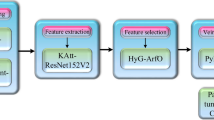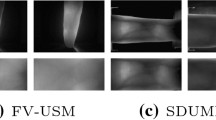Abstract
Finger vein recognition is an important biometric method, and its performance is easily affected by noise. The widely used Denoising Convolutional Neural Network (DnCNN ) and Fast and Flexible Denoising Network (FFDNet ) tend to have smoother images after denoising, and fail to fully retain information such as vein image edges and textures. To this end, a finger vein denoising net based on gradient-oriented residual structure and Local Binary Patterns (LBP) texture loss constraints, referred to as LGR-Net is proposed. First, a gradient direction operator is introduced in the residual structure to avoid the loss of gradient direction information in the denoised vein image. Second, the local features such as the texture of the shallow layer of the image are fused with the semantic information of the deep layer through the layer-skip connection, so as to preserve the semantic and local information of the denoised vein image as much as possible. Finally, an LBP loss term is added to the loss function to enhance the recovery ability of vein texture. The simulation experiments were carried out on the laboratory dust and stripe fingervein data sets. The results show that the proposed algorithm has better visual effect, Peak Signal-to-Noise Ratio (PSNR), and recognition performance, compared with the traditional Block-Matching and 3D filtering BM3D denoising algorithm, DnCNN algorithm, FFDNet algorithm and RDUNet algorithm.











Similar content being viewed by others
Availability of data and materials
The training dataset and testing dataset of this paper are not available due to trade secrets.
References
Wu, Jian-Da., Ye, Siou-Huan.: Driver identification using finger-vein patterns with Radon transform and neural network. Expert Systems with Applications 36(3), 5793–5799 (2009). (Elsevier)
Song, Jong Min, Kim, Wan, Park, Kang Ryoung: Finger-vein recognition based on deep DenseNet using composite image. Ieee Access 7, 66845–66863 (2019). (IEEE)
Ren, Hengyi, Sun, Lijuan, Guo, Jian, Han, Chong, Wu, Fan: Finger vein recognition system with template protection based on convolutional neural network. Knowledge-Based Systems 227, 107159 (2021). (Elsevier)
Thanh, Dang NH., Hien, Nguyen Ngoc, Kalavathi, P., Prasath, VB Surya.: Adaptive switching weight mean filter for salt and pepper image denoising. Procedia Computer Science 171, 292–301 (2020). (Elsevier)
Bhateja, Vikrant, Rastogi, Kartikeya, Verma, Aviral, Malhotra, Chirag: A non-iterative adaptive median filter for image denoising. 2014 International Conference on Signal Processing and Integrated Networks (SPIN), 171,113–118 (2014). IEEE
Chao, Shin-Min., Tsai, Du-Ming.: An improved anisotropic diffusion model for detail-and edge-preserving smoothing. Pattern Recognition Letters 31(13), 2012–2023 (2010). (Elsevier)
Chao, Shin-Min., Tsai, Du-Ming.: An improved anisotropic diffusion model for detail-and edge-preserving smoothing. Pattern Recognition Letters 27(5), 335–344 (2006). (Elsevier)
Jianhui, Xi., Li, Tang: Image denoising method based on improved wavelet threshold transform. 2019 IEEE Symposium Series on Computational Intelligence (SSCI) 31(13), 1064–1067 (2019). (IEEE)
Dabov, Kostadin, Foi, Alessandro, Katkovnik, Vladimir, Egiazarian, Karen: Image denoising method based on improved wavelet threshold transform. IEEE Transactions on image processing 16(8), 2080–2095 (2007). (IEEE)
Burger, Harold C., Schuler, Christian J., Harmeling, Stefan: Image denoising: Can plain neural networks compete with BM3D?. 2012 IEEE conference on computer vision and pattern recognition, pages 2392–2399 (2012). IEEE
Zhang, Kai, Zuo, Wangmeng, Chen, Yunjin, Meng, Deyu, Zhang, Lei: Beyond a gaussian denoiser: Residual learning of deep cnn for image denoising. IEEE transactions on image processing 26(7), 3142–3155 (2017). (IEEE)
Zhang, Kai, Zuo, Wangmeng, Zhang, Lei: FFDNet: Toward a fast and flexible solution for CNN-based image denoising. IEEE Transactions on Image Processing 27(9), 4608–4622 (2018). (IEEE)
Gurrola-Ramos, Javier, Dalmau, Oscar, Alarcn, Teresa E.: A Residual Dense U-Net Neural Network for Image Denoising. IEEE Access 9, 31742–31745 (2021). (IEEE)
Ojala, Timo, Pietikainen, Matti, Maenpaa, Topi: Multiresolution gray-scale and rotation invariant texture classification with local binary patterns. IEEE Transactions on pattern analysis and machine intelligence 24(7), 971–987 (2002). (IEEE)
Chen, Guobin, Jiang, Zhiyong, Kamruzzaman, M.M.: Radar remote sensing image retrieval algorithm based on improved Sobel operator. Journal of Visual Communication and Image Representation 71, 102720 (2020). (IEEE)
Wang, Xinzhi, Fang, Yifan, Li, Changdi, Gong, Shenjian, Yu, Lei, Fei, Shumin: Static gesture segmentation technique based on improved Sobel operator. The Journal of Engineering, 2019(22), 8339–8342 (2019). Wiley Online Library
Funding
This work is not supported by the fund.
Author information
Authors and Affiliations
Contributions
Lei Shen and Jiale Mou provided the idea of this paper. Mou Jiale completed the data organization and writing of this paper. Lei Shen provided some suggestions for data analysis. Yudong Yao and Huaxia Wang provided suggestions on paper writing. All authors reviewed the final manuscrip.
Corresponding author
Ethics declarations
Conflict of interest
The authors declare that they have no known competing financial interests or personal relationships that could have appeared to influence the work reported in this paper.
Ethical approval
Not applicable.
Additional information
Publisher's Note
Springer Nature remains neutral with regard to jurisdictional claims in published maps and institutional affiliations.
Rights and permissions
Springer Nature or its licensor (e.g. a society or other partner) holds exclusive rights to this article under a publishing agreement with the author(s) or other rightsholder(s); author self-archiving of the accepted manuscript version of this article is solely governed by the terms of such publishing agreement and applicable law.
About this article
Cite this article
Mou, J., Shen, L., Wang, H. et al. Finger vein denoising algorithm based on gradient-oriented residual structure and LBP texture loss. SIViP 18, 943–952 (2024). https://doi.org/10.1007/s11760-023-02795-6
Received:
Revised:
Accepted:
Published:
Issue Date:
DOI: https://doi.org/10.1007/s11760-023-02795-6




